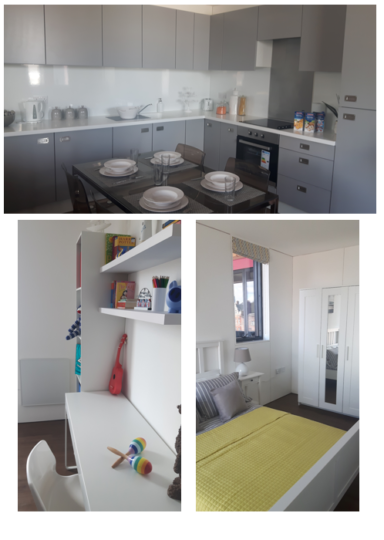Is ‘pop-up’ the answer to London’s homelessness crisis?
Published: by Shelter
Last summer we blogged about how pop-up homelessness accommodation was a quick-fix to England’s dire housing crisis. We wrote that while cheap pre-fab has a role to play as a quick relief for homeless families, it could never be a long-term solution, nor provide people with a sense of home.
Today, the London Borough of Lewisham officially unveiled their very own answer to the dire shortage of temporary homeless accommodation. PLACE in Ladywell – a council built and managed scheme – comprises of 24 two bedroom flats. It’s in the centre of the borough, a short walk from the council offices, shops, schools and transport.
 |
The flats will be allocated to families who have recently been made homeless and are in priority need – typically those with children.
The accommodation is high quality – well insulated for warmth and against noise from the adjoining flats. And at 75 square metres each flat exceeds the London space standard. Our impression of PLACE is that – unlike the alternative pop-up we blogged about in the past – it feels very much like home. It’s an ideal stop-gap for families, while they wait to be offered somewhere permanent to live in.
One officer from Lewisham council referred to an offer of a flat at PLACE as being the ‘golden ticket’ of homelessness accommodation. It is certainly of a quality few of the families in temporary housing that Shelter works with have ever experienced.
 |
The site also includes retail space, a coffee shop, offices and space for local groups, making it a focal point for the community and a source of desperately-needed employment.
So is there a downside to PLACE? Well, for all the hype and the grand opening, at the end of the day we are only talking about 24 flats – so 24 homeless households provided with accommodation. Lewisham are currently accommodating over 1,700 households in temporary accommodation. Due to a dire shortage of housing in the borough, the council has been forced to move 400 of these households out of Lewisham.
But while PLACE represents just a small step in the right direction, it does fly the flag for councils taking a firmer grasp of the homelessness crisis themselves. It should be used as an exemplar for other authorities.
Lewisham used their own land as the site for the development. There are many more public sites all over London and other cities, which could be used to temporarily address our housing crisis while longer-term solutions are built.
Each flat at PLACE cost £120,000 to construct. But because temporary accommodation is so costly in Lewisham, PLACE will pay for itself over 10 years by avoiding the extra costs that would normally go to private landlords. The building has a 60 year shelf-life too, and can be moved several times to different locations. So if the housing crisis deepens, PLACE will continue to play a vital role in accommodating homeless families.
PLACE also means that there will be 24 households who won’t have to be moved out of Lewisham, or have to live in cramped bed and breakfast and expensive private rented accommodation. Families being accommodated outside their local area is growing issue. Our research shows that last year, more than half of London’s homeless households were moved away from their local area. 10% of these households were moved out of London entirely.
So Lewisham have demonstrated that councils have the means to innovate to keep homeless households from being forced into unsuitable accommodation.
Of course, innovative temporary accommodation solutions like PLACE won’t prevent homelessness. Nor do they offer a permanent solution. In Lewisham, private rents have soared over the last few years and the loss of a home in the private rented sector is now the leading cause of homelessness, making prevention of homelessness more challenging. However, the Government will soon be publishing proposals on a new temporary accommodation fund for councils. Innovative schemes such as this should certainly be part of the mix.